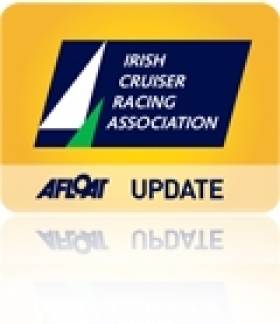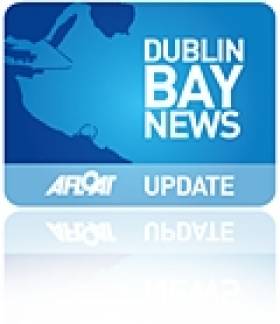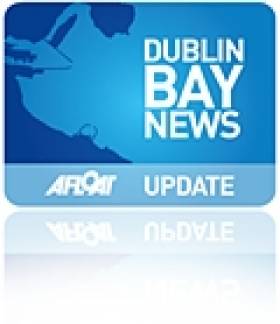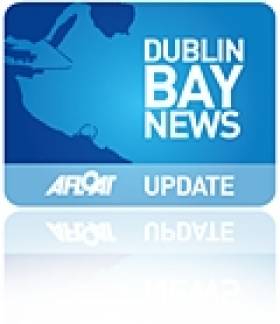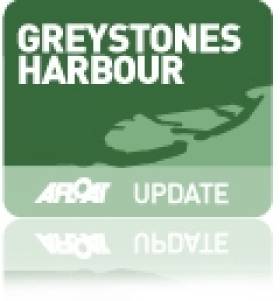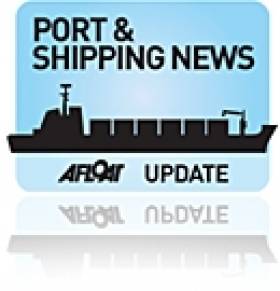Displaying items by tag: Harbour
ICRA Racing Underway in Crosshaven
Dun Laoghaire Harbour Masterplan Launched
Dun Laoghaire Harbour hopes to create 1000 new jobs according to the new Consultation Harbour Masterplan, on public display this Saturday and Sunday from 12 noon to 6pm at the Terminal building in the harbour. Mr Leo Varadkar, T.D., Minister for Transport, Tourism and Sport visited the Harbour Board today to view the Masterplan model and the plans.
The Dun Laoghaire Waterfront Yacht Club's Submission to the Harbour Masterplan is Here.
"The Masterplan will position Dun Laoghaire Harbour as a marine, leisure and tourism destination of international calibre", says Gerry Dunne, Chief Executive Officer, Dun Laoghaire Harbour Board. "We need to spend an average of €5m a year on maintaining and developing the Harbour infrastructure. The Masterplan will involve investment of more than €230m, over the next 10-15 years and will result in 1000 sustainable jobs in areas such as tourism, marine service companies, select retail, and food and beverage."
Leo Varadkar TD, Minister for Transport, Tourism & Sport said "I welcome the master-planning initiative being taken by Dun Laoghaire Harbour Company. This is in line with international best practice and with measures to improve integrated transport planning more generally. I know there is very keen local interest in the future development of the harbour and I would encourage all the local stakeholders to participate positively in the process.
"In addition to being a successful commercial ferry port, this harbour is also the State's largest marine leisure amenity, an important maritime heritage site, and host to what is reputed to be the nation's most popular walk. The masterplan will help the company to successfully manage these multiple roles the future.
"I am particularly interested in making the most of the harbour's potential, both as a tourist attraction in its own right and as an attractive gateway for tourists to enter the country."
Major highlights of the Masterplan will be an International Diaspora Centre on the Carlisle Pier, which is expected to attract over 1 million visitors per year. There will be other major commercial attractions, appropriate residential development and a new cruise berthing facility to enable Dublin Bay to welcome the Next Generation Cruise Ships to Dun Laoghaire.
There will be many improvements for the public and the many Voluntary Groups who use the amenities of the harbour, including a huge increase in public access to the waterfront, new slipways for the general public to use, and a new public marina. The Masterplan is also making a specific commitment to enable Dun Laoghaire and Dublin Bay to host major International Sailing Events every year.
The Consultation Masterplan shows the Harbour Company's current thinking and asks people again for their views. It takes into account all the ideas received by post and through the www.dlharbour.ie/masterplan website, the survey of people walking the East Pier as well as the meetings held over the last six months with different stakeholders who live and run businesses in the area.
"Dun Laoghaire harbour is one of the most beautiful man-made harbours in the world. We want it to be recognised internationally as an exciting waterfront, marine and tourist destination – one which elegantly integrates the local town with a historic 200 year old harbour and offers a striking combination of modern amenities mixed with a traditional marine ambience in a Dublin Bay setting," says Dunne.
Dun Laoghaire's new Harbour master is Captain Frank Allen, according to an announcement by Dun Laoghaire Harbour Company this morning.
Captain Allen replaces Captain Simon Coate who is retiring.
A native of Cork, Captain Allen has spent all his working life in shipping. His first management role was as General Manager of Dundlak shipowners from 1986 to 1997. He was then appointed Ships captain for Carrisbrooke Shipping in the UK and subsequently worked as Operations Manager for Swansea Cork Ferries from 199 to 2003 before joining Dundalk Port as Harbour Master.
The Harbour Company is about to launch a Masterplan for the 200 year old harbour., the country's largest sailing and boating centre.
Students Sail into Banagher's Heritage Harbour
As the first vessel edged under the Bridge and the inland waterways. Fleet turned purposely into Banagher Harbour, it was clear that these were no ordinary boats. These were the vanguard of the Heritage Boats that are celebrating the 10th anniversary of their association over the coming weeks.
The 6th Class students of Saint Rynagh's National School were eagerly awaiting the arrival of the fleet. In recent weeks they have been participating is a project centred round the Heritage Boats, their links with Banagher and incorporating the wider heritage and history of the Shannon River. The students, supported by the school principal Mr Fergal McMahon, class teacher Ms Catherine Dolan and associate teacher and local historian Mr James Scully, explored the impact that the River Shannon has had on the town and its hinterland over the centuries.
The Heritage Boats, now visiting the town's harbour, are the very same boats that many decades ago carried the cargos that were the lifeblood of the nation's commerce. Banagher was an important harbour and distribution point on the inland waterway system.
Supported by Offaly County Council and with the great help of renowned artist Ms Rosalind Fanning from the Tin Jug Studio in Birr, the students have documented their work in a unique publication called "HBA 10 @ Banagher".
With their many new young fans, the old boats of the fleet of the Heritage Boat Association are assured a warm welcome in Banagher in the decades ahead.
Dun Laoghaire Sailing Clubs Say Future is in Leisure
Dun Laoghaire's future lies in tourism and leisure, according to a submission on the new 'master plan' for the busy harbour.
The Irish Times reports that the town's top sailing and yacht clubs, who have come together under the banner of Dun Laoghaire Combined Clubs, are putting aside their individual interests "in favour of a larger and longer-term vision for the harbour".
The clubs' submission urges a rethink on public access to both the shore and water sides of the harbour. Inprovements in linking the town with the harbour area are already a goal of the master plan.
"Properly developed with a marine tourism and leisure focus [Dun Laoghaire] can generate new and sustainable sources of income." they said.
Dun Laoghaire Combined Clubs comprises the 'big four' waterfront clubs - the National, Royal Irish, Royal St George and Dun Laoghaire Motor Yacht Club - as well as the Dublin Bay Sailing Club and the Royal Alfred Yacht Club.
The Irish Times has more on the story HERE.
Harbour Businesses Vent Frustration at DAFF
A Donegal businessman is fronting a new campaign that seeks a more positive and direct approach to supporting harbour businesses.
John Shine - who spearheads the 'Fishing for Jobs' campaign - has accused the Department of Agriculture, Fisheries and Food (DAFF) of thwarting the growth of his and others' businesses "at every turn", The Irish Times reports.
Shine and his fellow campaigners want a full policy adaptation of the 2009 McIver report on the development of business plans for harbour centres, which found a "lack of business focus" among harbour and department officials.
The report noted that existing harbour business tenants had "frustrating" relationships with the DAFF especially with regard to leases. Shine said approximately 40% of property in Killybegs harbour, which has benefited from a €50m development, is lying idle due to a "negative" approach by the DAFF.
The Irish Times has more on the story HERE.
Council Bond Ensures Greystones Harbour will Open - Councillor
Wicklow Councillor Derek Mitchell has moved to reassure frustrated boaters and townspeople alike that the partially completed €300 million Greystones Harbour and Marina will be completed. In a letter to the Irish Times this morning the councillor acknowledges that the delays are 'frustrating' but advises the council holds a €5 million bond to ensure the project will be completed.
A recent survey of prospective boat owners found 80% of berths required in the proposed 200 berth marina would be under eight mertres. Mitchell admitted earlier this year more interest from boat owners was required to get the marina underway.
The council bond is not exercisable until 2014.
A slipway at the community harbour is operational but the public square and five free clubhouses for different boating activities from angling to sailing are still to be provided. Last November builders Sispar held an open day to show off the impressive marine works.
A spokesperson for development consortium Sispar previously advised the decision on funding the next phase rests with that National Assets Management Agency (Nama).
Ambitious Project Floated for Dun Laoghaire Harbour
Top British architects have won the commission to develop an ambitious master plan for Dun Laoghaire Harbour.
The Dun Laoghaire Gazette reports that Metropolitan Workshop have been tasked examining the feasibility of redeveloping the port to attract cruise liners carrying 100,000 passengers annually.
The plan, to be completed by the summer, is aimed at realising Dun Laoghaire's potential "as a major marine, leisure and tourism destination".
Improved public spaces linking the town and the harbour, tourism opportunities and new cultural attractions are just some of the proposals that the plan will take into consideration.
Jonny McKenna of Metropolitan Workshop old the Gazette: "Our approach is anchored in Dun Laoghaire's history and heritage. Our aim is to broaden the appeal of the harbour, both locally and internationally, as a world-class waterfront destination."
The consultation and drafting phase of the master plan will be completed by the end of this month.
80% of Berths Required in Greystones are Under 8 Metres
A newsletter giving details of the most popular size berth requirements at the proposed Greystones Harbour Marina has been sent to boat owners on a waiting list for the Wicklow marina.
The analysis finds 80% of the berths required are under 10 metres (32 foot). Only 2 berths were required for boats over 13m (42 feet).
In nearby Dun Laoghaire, at the country's biggest marina, the 820 berths there range in size from 6m (19 feet) to 30m (98 feet). The average berth requirement on Dublin Bay is 9-10m (29-32 feet).
The March newsletter says examination of the waiting list revealed duplication of an original waiting list which prompted a fresh exercise to establish the current market demand in 2011. The new survey of 300 people was carried out by a marina consultant, working for developer Sispar. It delivered 79 responses. An extract from the analysis is below.
The tabulation from the newsletter reflects the breakdown of the responses in terms of current berth size numbers and the extrapolation into the requirement for totals when fully developed based on to-days statistics.
| Berth Size | Numbers to 6/1/11 | % of Current Market | Full Dev Berth Nos. |
|
| <6m | 9 | 12.4 | 29 | |
| 6-7m | 12 | 15.2 | 35 | |
| 7-8m | 14 | 17.7 | 41 | |
| 8-9m | 5 | 6.3 | 15 | |
| 9-10m | 17 | 21.5 | 50 | |
| 10-11m | 8 | 10.1 | 24 | |
| 11-12m | 6 | 7.6 | 18 | |
| 12m-13m | 6 | 7.6 | 18 | |
| >13m | 2 | 2.6 | 5 | |
| Total | 79 | 101 | 235 |
Reporting Inadequate Facilities for Handing Ship-Generated Waste
The Department of Transport's latest marine notice lays out the format for reporting inadequate harbour facilities for handling ship-generated waste.
Shipping companies depend on good standards at receiving ports and harbours in order to comply with the relevant EU directive. But the notice outlines that improvement of port facilities' waste handling is partly dependent on users reporting any inadequacies.
The notice includes the International Maritime Organization's standard format for reporting unsatisfactory port reception facilities.
For all ships, reports should be sent to the relevant port authority as well as the Ship-Source Pollution Prevention Section of the Department of Transport. Non-Irish flagged ships in Irish ports should also send any reports to the ship's flag state.
A PDF of Marine Notice No 17 of 2011 can be viewed/downloaded HERE.


























